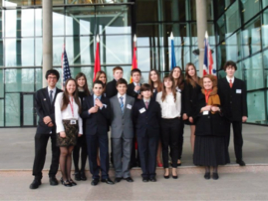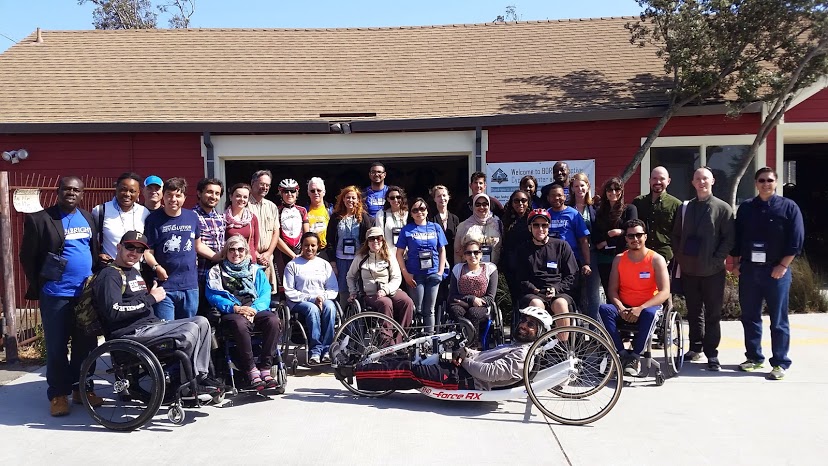
Rio Bauce, 2012-2013, Fulbright English Teaching Assistant to Spain (right, standing), observing a student delegate speak about clean water in a UN conference committee in CRIF Las Acacias in Madrid
I would like to dedicate this post to my mother, Meryl Zelda Kolevzon, who has provided me with the inspiration for this article. In August 1998, she passed away after a long battle with breast cancer. She would have been 69 on October 9th, 2014. Her ability to smile through all of her struggles has showed me the power a smile on those around you, even when they are under difficult circumstances.
The sense of wonder a student feels after a teacher pauses in the middle of a thrilling story, a high-pitched laugh at a joke told on the schoolyard, a parent admiring their child’s drawing of a goat. Curiosity, humor, and joy are emotions that make lasting imprints on a child’s education. In April 2012, I was selected to become a Fulbright English Teaching Assistant (ETA) in Madrid, Spain. That September, I left California to be an ETA at IES José Luis Sampedro in Tres Cantos, Spain. On the first day of school, teachers and students at my suburban school thirty kilometers outside of Madrid were nervous to begin school and hoped that everything would function smoothly. From my experience, the last three years teaching in a classroom setting, one of the most powerful tools that teachers have in their arsenal to make students feel safe is an uncompromising smile.
A peaceful classroom environment, a product of student accountability and mutual respect, combined with interesting lesson plans allows students to succeed. During my two years in Spain as a Fulbright grantee, I co-taught a politics course with another Fulbright recipient. In this class, we challenged our pupils to work in teams as country representatives, performing research, and writing position papers on complex issues, such as potable water. Many of these students had never performed research and written a structured essay in Spanish, let alone in English. According to a post-course survey, eighty-eight percent of my students reported that they had experienced improvement in their language skills during the year and ninety-four percent said that they would recommend the class to a friend. Many cited the fairness in discipline and the positive demeanor of the teachers as key indicators of their satisfaction. Although teaching is an experiment, being a friendly teacher is not rocket science. It is the right thing to do.

Rio Bauce, 2012-2013, Fulbright English Teaching Assistant to Spain (far left), with another Fulbright grantee, Hannah Connor, a Spanish teacher, Mercedes, and twelve of our students at the Asamblea de Madrid, kicking off a two-day conference on clean water
Greeting students with compassion is one of the most effective tools I have found for creating a culture of learning. Inside class, the students greet me with a high five and a smile. During the 2012 U.S. Presidential elections, students asked me questions that led to debates on difficult issues, like the merits of gun culture or the best solution to climate change. On the schoolyard, students would offer me their snacks, shake my hand, and tell me about their weekends. To them, all I needed to do was flash my pearly whites. Many seasoned teachers will tell you that being nice to students will weaken your authority. Nothing can be further from the truth. After my first two months at school, I began to realize that these kids were capable of even more that I had ever imagined.
During my first year, I engaged an outside learning opportunity with the creation of the WhatsApp Times, the first-ever student-run English-language newspaper in Madrid. With the help of the school administration, I met with English teachers to help identify and recruit high-performing students. In December, I came together with a team of brilliant student-writers to release the first edition of the WhatsApp Times that spanned twenty pages. Students were at the helm of the ship, leading everything from the naming of the newspaper and selection of the mascot to designing the front page.
The students made such an impression on me that I decided to return to teach for a second year and I am glad that I did. This past year, I further exploited situations that feed students’ quest for knowledge, helping a boy understand the structure of the United Nations and a shy 14-year-old girl to feed her curiosity about the 1989 San Francisco earthquake. These wonderful moments are the building blocks of a culture that motivates bilingual education, and it all starts with a smile. If this sounds like an experience you may enjoy, I would highly encourage you to apply. The most important things are be clear, concise, and specific about why you would make a great Fulbright English Teaching Assistant in Spain. It was an experience of a lifetime and you won’t regret applying!



No Comments